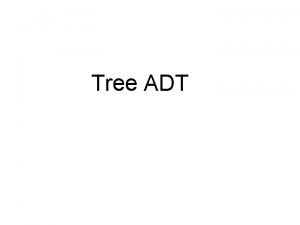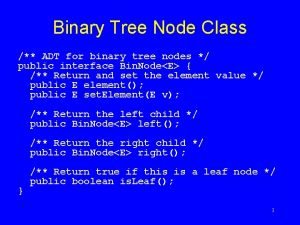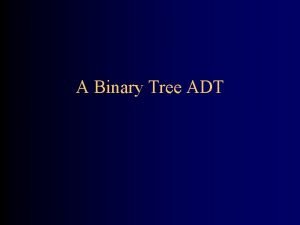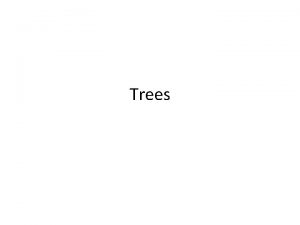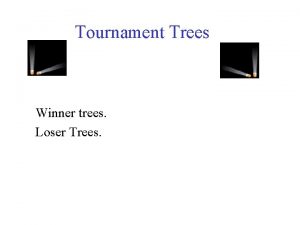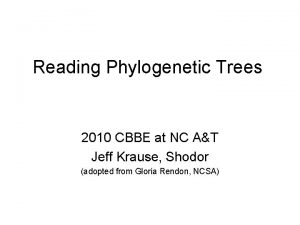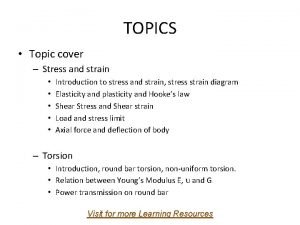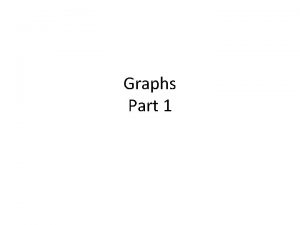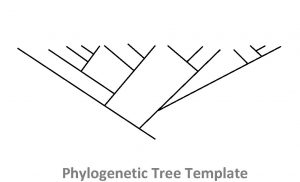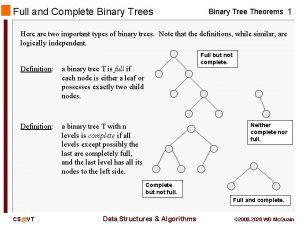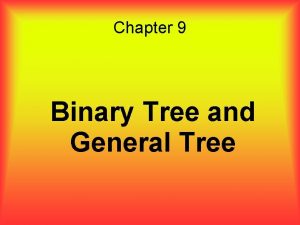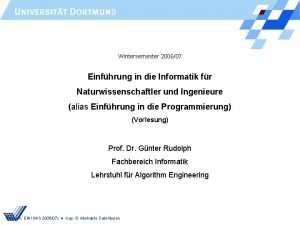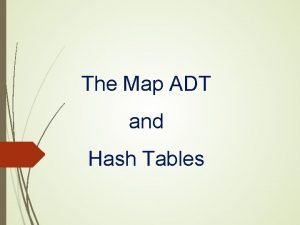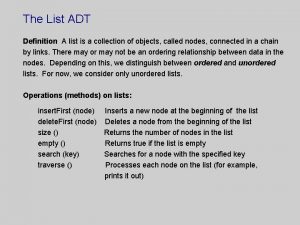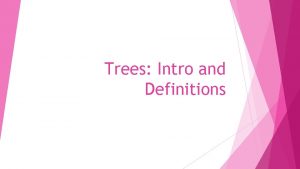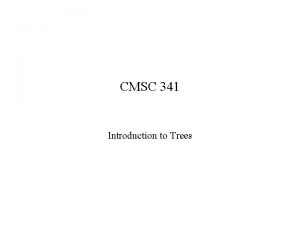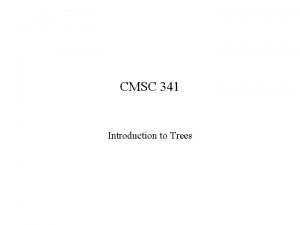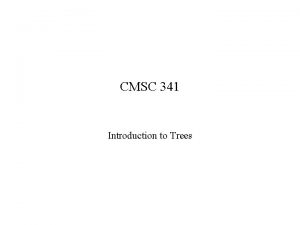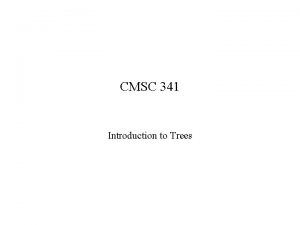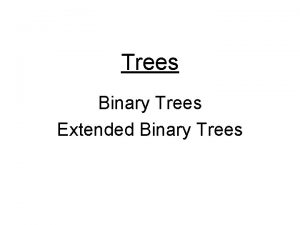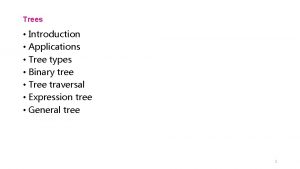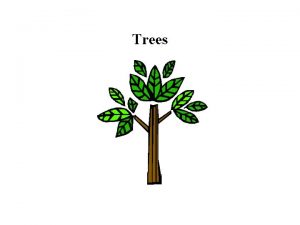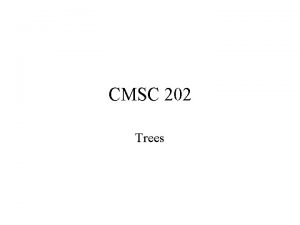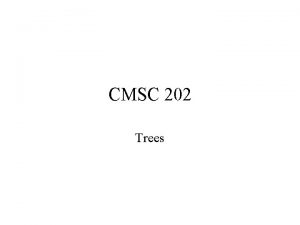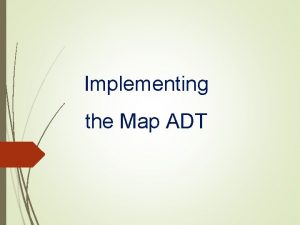Trees Outline and Reading Tree Definitions and ADT



































- Slides: 35

Trees

Outline and Reading • Tree Definitions and ADT (§ 7. 1) • Tree Traversal Algorithms for General Trees (preorder and postorder) (§ 7. 2) • Binary. Trees (§ 7. 3) • Data structures for trees (§ 7. 1. 4 and § 7. 3. 4) • Traversals of Binary Trees (preorder, inorder, postorder) (§ 7. 3. 6) • Euler Tours (§ 7. 3. 7)

What is a Tree • In Computer Science, a tree is an abstract model of a hierarchical structure • A tree consists of nodes with a parent-child relation • Applications: – Organization charts – File systems Computers”R”Us Sales US Europe Manufacturing International Asia Laptops Canada Desktops R&D

Tree Terminology • Subtree: tree consisting of a • Root: node without parent (A) node and its descendants • Internal node: node with at least one child (A, B, C, F) • Leaf (aka External node): node without A children (E, I, J, K, G, H, D) • Ancestors of a node: parent, grandparent, great-grandparent, etc. C B • Depth of a node: number of ancestors • Height of a tree: maximum depth of any node (3) G E F H subtee • Descendant of a node: child, grandchild, great-grandchild, etc. I J K D

Exercise: Trees • Answer the following questions about the tree shown on the right: – What is the size of the tree (number of nodes)? B – Classify each node of the tree as a root, leaf, or internal node – List the ancestors of nodes B, F, G, and A. Which are the parents? E – List the descendents of nodes B, F, G, and A. Which are the children? – List the depths of nodes B, F, G, and A. I – What is the height of the tree? – Draw the subtrees that are rooted at node F and at node K. A D C F J G K H

Tree ADT • We use positions to abstract nodes • Generic methods: • • integer size() boolean is. Empty() object. Iterator elements() position. Iterator positions() • Accessor methods: • position root() • position parent(p) • position. Iterator children(p) • Query methods: boolean is. Internal(p) • boolean is. Leaf (p) • boolean is. Root(p) Update methods: • swap. Elements(p, q) • object replace. Element(p, o) Additional update methods may be defined by data structures implementing the Tree ADT • • •

A Linked Structure for General Trees • A node is represented by an object storing • • Element Parent node Sequence of children nodes B Node objects implement the Position ADT A D F B D A F C C E E

A Linked Structure for General Trees • A node is represented by an object storing • • Element Parent node Sequence of children nodes B Node objects implement the Position ADT A D F B D A F C C E E

A Linked Structure for General Trees • A node is represented by an object storing • • Element Parent node Sequence of children nodes B Node objects implement the Position ADT A D F B D A F C C E E

A Linked Structure for General Trees • A node is represented by an object storing • • Element Parent node Sequence of children nodes B Node objects implement the Position ADT A D F B D A F C C E E

Preorder Traversal • A traversal visits the nodes of a tree in a systematic manner • In a preorder traversal, a node is visited before its descendants • Application: print a structured document Algorithm pre. Order(v) visit(v) for each child w of v pre. Order(w) 1 Data Structures & Algorithms 2 2. Object-Oriented Design 1. A C++ Primer 3 1. 1 Basic C++ Programming Elements 9 5 4 1. 2 Expressions 6 2. 1 Goals, Principles, and Patterns 7 2. 2 Inheritance and Polymorphism Bibliography 8 2. 3 Templates

Exercise: Preorder Traversal • In a preorder traversal, a node is visited before its descendants • List the nodes of this tree in preorder traversal order. A B E Algorithm pre. Order(v) visit(v) for each child w of v pre. Order (w) F I D C J G K H

Postorder Traversal • In a postorder traversal, a node is visited after its descendants • Application: compute space used by files in a directory and its subdirectories 9 Algorithm post. Order(v) for each child w of v post. Order(w) visit(v) cs 16/ 3 8 7 homeworks/ todo. txt 1 K programs/ 1 2 h 1 c. doc 3 K h 1 nc. doc 2 K 4 DDR. java 10 K 5 Stocks. java 25 K 6 Robot. java 20 K

Exercise: Postorder Traversal A • In a postorder traversal, a node is visited • after its descendants List the nodes of this tree in postorder traversal order. B E Algorithm post. Order(v) for each child w of v post. Order(w) visit(v) F I D C J G K H

Binary Tree • A binary tree is a tree with the following properties: • Applications: • Each internal node has two children • The children of a node are an ordered pair • • • We call the children of an internal node left child and right child • Alternative recursive definition: a binary tree is either • a tree consisting of a single node, or • a tree whose root has an ordered pair of children, each of which is a binary tree arithmetic expressions decision processes searching • A B C D F E H I G

Arithmetic Expression Tree • Binary tree associated with an arithmetic expression • internal nodes: operators • leaves: operands • Example: arithmetic expression tree for the expression (2 (a - 1) + (3 b)) + - 2 a 3 1 b

Decision Tree • Binary tree associated with a decision process • internal nodes: questions with yes/no answer • leaves: decisions • Example: dining decision Want a fast meal? No Yes On expense account? How about coffee? Yes Starbucks No Antonio’s Yes Veritas No Chili’s

Properties of Binary Trees • Notation n number of nodes l number of leaves i number of internal nodes h height • Properties: • • l=i+1 n = 2 l - 1 h i h (n - 1)/2 l 2 h h log 2 l h log 2 (n + 1) - 1

Properties of Binary Trees • Full (or proper) binary tree • All nodes have either 0 or 2 children

Properties of Binary Trees • Complete binary tree with height h • All 2 h-1 nodes exist at height h-1 • Nodes at level h fill up left to right

Binary. Tree ADT • The Binary. Tree ADT extends the Tree ADT, i. e. , it inherits all the methods of the Tree ADT • Additional methods: • position left. Child(p) • position right. Child(p) • position sibling(p) • Update methods may be defined by data structures implementing the Binary. Tree ADT

A Linked Structure for Binary Trees • A node is represented by an object storing • • • Element Parent node Left child node Right child node B Node objects implement the Position ADT B A A D C D E C E

Inorder Traversal • In an inorder traversal a node Algorithm in. Order(v) is visited after its left subtree if is. Internal(v) and before its right subtree in. Order(left. Child(v)) • Application: draw a binary tree visit(v) • x(v) = inorder rank of v • y(v) = depth of v if is. Internal(v) in. Order(right. Child(v)) 6 2 8 1 4 3 7 5 9

Exercise: Inorder Traversal • In an inorder traversal a node is visited after its left subtree and before its right subtree • List the nodes of this tree in inorder traversal order. A B E Algorithm in. Order(v) if is. Internal(v) in. Order(left. Child(v)) visit(v) if is. Internal(v) in. Order(right. Child(v)) C F I G K H

Exercise: Preorder & In. Order Traversal • Draw a (single) binary tree T, such that • Each internal node of T stores a single character • A preorder traversal of T yields EXAMFUN • An inorder traversal of T yields MAFXUEN

Print Arithmetic Expressions • Algorithm print. Expression(v) if is. Internal(v) print(“(’’) • print operand or operator when visiting node print. Expression(left. Child(v)) • print “(“ before traversing left print(v. element()) subtree if is. Internal(v) • print “)“ after traversing right print. Expression(right. Child(v)) subtree print (“)’’) + Specialization of an inorder traversal - 2 3 b ((2 (a - 1)) + (3 b)) a 1

Evaluate Arithmetic Expressions Algorithm eval. Expr(v) if is. Leaf(v) return v. element() else x eval. Expr(left. Child(v)) y eval. Expr(right. Child(v)) operator stored at v return x y • Specialization of a postorder traversal • recursive method returning the value of a subtree • when visiting an internal node, combine the values of the subtrees + - 2 a 3 1 b

Exercise: Arithmetic Expressions • Draw an expression tree that has • Four leaves, storing the values 2, 4, 8, and 8 • 3 internal nodes, storing operations +, -, *, / (operators can be used more than once, but each internal node stores only one) • The value of the root is 24

Exercise: Arithmetic Expressions • Draw an expression tree that has • Four leaves, storing the values 2, 4, 8, and 8 • 3 internal nodes, storing operations +, -, *, / (operators can be used more than once, but each internal node stores only one) • The value of the root is 24 + + 8 8 2 4

Exercise: Arithmetic Expressions • Draw an expression tree that has • Four leaves, storing the values 1, 3, 4, and 8 • 3 internal nodes, storing operations +, -, *, / (operators can be used more than once, but each internal node stores only one) • The value of the root is 24

Euler Tour Traversal • • • Generic traversal of a binary tree Includes as special cases the preorder, postorder and inorder traversals Walk around the tree and visit each node three times: • on the left (preorder) • from below (inorder) • on the right (postorder) + L 2 R B 5 3 1 2

Euler Tour Traversal Algorithm euler. Tour(p) left-visit-action(p) if is. Internal(p) euler. Tour(p. left()) bottom-visit-action(p) if is. Internal(p) euler. Tour(p. right()) right-visit-action(p) End Algorithm + L 2 R B 5 3 1 2

Print Arithmetic Expressions • Algorithm print. Expression(p) if is. External(p) then print value stored at p Else print “(“ print. Expression(p. left()) Print the operator stored at p print. Expression(p. right()) print “)” Endif End Algorithm Specialization of an Euler Tour traversal • • • Left-visit-action: if node is internal, print “(“ Bottom-visit-action: print value or operator stored at node Right-visit-action: if node is internal, print “)” + - 2 3 b ((2 (a - 1)) + (3 b)) a 1

Template Method Pattern • Generic algorithm that can be specialized by redefining certain steps • Implemented by means of an abstract C++ class • Visit methods that can be redefined by subclasses • Template method euler. Tour • Recursively called on the left and right children • A Result object with fields left. Result, right. Result and final. Result keeps track of the output of the recursive calls to euler. Tour class Euler. Tour { protected: Binary. Tree* tree; virtual void visit. Leaf(Position p, Result r) { } virtual void visit. Left(Position p, Result r) { } virtual void visit. Below(Position p, Result r) { } virtual void visit. Right(Position p, Result r) { } int euler. Tour(Position p) { Result r = init. Result(); if (tree–>is. Leaf(p)) { visit. Leaf(p, r); return r. final. Result; } else { visit. Left(p, r); r. left. Result = euler. Tour(tree– >left. Child(p)); visit. Below(p, r); r. right. Result = euler. Tour(tree– >right. Child(p)); visit. Right(p, r); return r. final. Result;

Specializations of Euler. Tour • We show to specialize class Euler. Tour to evaluate an arithmetic expression • Assumptions • External nodes support a function value(), which returns the value of this node. • Internal nodes provide a function operation(int, int), which returns the result of some binary operator on integers. class Evaluate. Expression : public Euler. Tour { protected: void visit. Leaf(Position p, Result r) { r. final. Result = p. element(). value(); } void visit. Right(Position p, Result r) { Operator op = p. element(). operator(); r. final. Result = op. operation( r. left. Result, r. right. Result); } // … other details omitted };
 While reading activities
While reading activities Tree adt
Tree adt Binary tree adt
Binary tree adt Binary tree adt
Binary tree adt Adt tree
Adt tree 2-3 tree
2-3 tree Meaning of reading strategy
Meaning of reading strategy Loser tree
Loser tree Loser tree
Loser tree Loser tree
Loser tree Quotation sandwich
Quotation sandwich Reading phylogenetic trees
Reading phylogenetic trees Stress and strain reading outline
Stress and strain reading outline Reading outline example
Reading outline example Phylogenetic tree outline
Phylogenetic tree outline Aims and objectives of teaching
Aims and objectives of teaching Types of reading skills
Types of reading skills What is extensive reading
What is extensive reading Intensive and extensive reading
Intensive and extensive reading What is intensive reading
What is intensive reading Foragry
Foragry Full binary tree definition
Full binary tree definition Threaded binary tree traversal
Threaded binary tree traversal Solution tree example
Solution tree example Objective analysis tree
Objective analysis tree Problem tree and objective tree
Problem tree and objective tree General tree to binary tree
General tree to binary tree St. louis
St. louis Edb net section
Edb net section Critical reading
Critical reading Post reading the split cherry tree
Post reading the split cherry tree The magic key youtube
The magic key youtube Oxford reading budy
Oxford reading budy Adt informatik
Adt informatik Map adt
Map adt Node list adt
Node list adt

